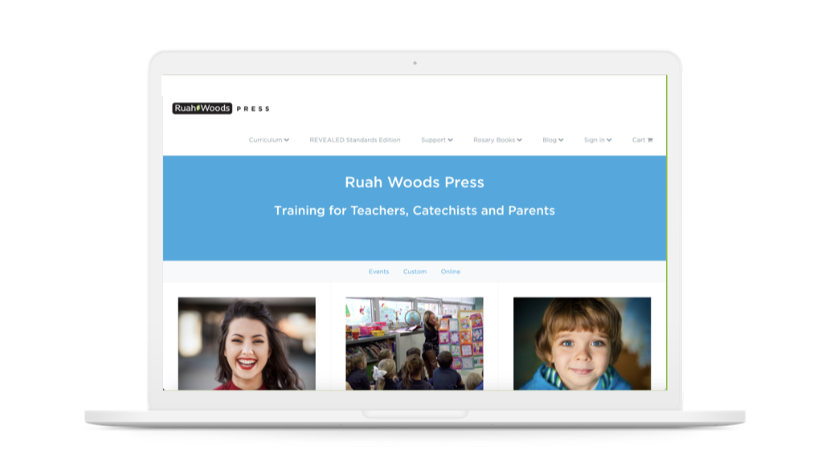
Called to Be More
Theology of the Body curriculum for high school classrooms
Theology of the Body for High School
Our teens are struggling to find their place in the world. If we want to combat the loneliness and alienation, anxiety and confusion they are facing, we need the life-giving truths found in the teachings of Pope St. John Paul II’s masterwork, The Theology of the Body. We created the Theology of the Body high school curriculum, Called to Be More, to give educators tools and a simple language to help teens become who God made them to be—instead of who the world says they should be.
- Easy to implement and incorporate
- 7-10 lessons per semester that mesh easily into common high school theology classes
- Requires no prior Theology of the Body experience
- Easy to follow foundational lessons you can teach at your own pace
- Assign online material or print out for in-class discussion
- Grant students access to the entire curriculum or to specific lessons
- Follows USCCB Doctrinal curriculum framework
- 5-week no obligation free trial available

Hear from high school teachers across the nation how much they love our Theology of the Body curriculum.
What the Theology of the Body for high school curriculum teaches vs. what it is not.
WHAT IT IS:
- What it means to be male and female, created in God’s image
- We are created as a gift
- God gives us an essential purpose to live for others
- We are called to authentically love God and one another
- When we align with God and our purpose, we are destined for happiness
- Understanding how God reveals himself through Jesus, marriage, the sacraments, and more
- The dignity of each human person, and their calls to work and love
- God’s plan for marital relationships
WHAT IT IS NOT:
- A chastity program
- Too hard for the common person to understand
- A bunch of rules
- Only focused on human sexuality
- Revolutionary or a break with tradition
- A biology textbook
- A “fad” or trend
- Sex Ed.

CURRICULUM PRICING
Affordable Pricing
An online subscription to Theology of the Body for teens is $10 per student per year, or $5 per semester.
A 5-week no obligation free trial is available to preview content.

Educator Support
Access training and resources to help you teach the truth with clarity and compassion.
Theology of the Body for Teens
Our online Theology of the Body high school curriculum is intended to strengthen teens’ faith, their relationship with God and friends, and to change their perspective on life. Through the Called to Be More curriculum, teens will also be equipped to articulate their faith to family, friends, co-workers, classmates and others who challenge their beliefs.
Lessons
7-10 lessons per semester that mesh easily into common high school theology classes.

Every lesson in Called to Be More digitally provides tools an educator needs:
- Opening Prayer
- Written Lesson
- Discussion Questions
- Activities
- Recommended Video Clips and Movies
- Original Testimony Video
- Essay Suggestions
- Biography of a Saint
- Quiz and Answer Key

CUSTOMER REVIEWS
High School Curriculum Overview
Course details and sample materials for Grades 9-12
The Revelation of Jesus Christ in Scripture
Download sample material
- 1.1 Who is St. John Paul II?
- 1.2 Why Does God Reveal Himself?
- 1.3 How Does God Reveal Himself?
- 1.4 Genesis 1-2
- 1.5 Marital Imagery in Scripture
- 1.6 Jesus Christ Reveals Man to Himself
- 1.7 Prayer
Who is Jesus Christ?
- 2.1 Jesus Christ and Revelation
- 2.2 The Trinity
- 2.3 Receiving Life as a Gift
- 2.4 Love
- 2.5 Sexual Difference – Visible Sign of Love
- 2.6 Womanhood
- 2.7 Manhood
- 2.8 Friendship
- 2.9 Suffering
The Mission of Jesus Christ (The Paschal Mystery)
- 3.1 Creation
- 3.2 The Original Experiences
- 3.3 The Fall
- 3.4 Historical Man
- 3.5 Dignity of the Human Person
- 3.6 Dignity with Disabilities
- 3.7 Dignity and Dating
- 3.8 Eschatological Man
Jesus Christ’s Mission Continues in the Church
- 4.1 The Church as Bride
- 4.2 Spousal Meaning of the Body
- 4.3 Femininity and Masculinity
- 4.4 Vocation as a Call to Love
- 4.5 The Domestic Church
- 4.6 The Church as the Body of Christ
- 4.7 The New Evangelization
Sacraments as Privileged Encounters with Jesus Christ
- 5.1 Sacraments and the Body
- 5.2 Baptism
- 5.3 Eucharist
- 5.4 Confirmation
- 5.5 Reconciliation
- 5.6 Anointing of the Sick
- 5.7 Marriage
- 5.8 Marriage and Divorce
- 5.9 Holy Orders
- 5.10 Embracing a Sacramental View of the World
Life in Jesus Christ
- 6.1 Moral Life as a Response
- 6.2 The Language of the Body
- 6.3 The Dignity of the Body (Chastity)
- 6.4 The Dignity of Fruitfulness
- 6.5 The Dignity of Sexual Difference
- 6.6 The Dignity of Self
- 6.7 The Dignity of Relationships (Technology)
Living as a Disciple of Jesus Christ in Society
- 7.1 Who is the Human Person?
- 7.2 Truth and Love
- 7.3 The Family as the Cell of Society
- 7.4 Structures of Sin
- 7.5 Suffering and Death
- 7.6 The Dignity of Work
- 7.7 Care of Creation
Responding to the Call of Jesus Christ
- 8.1 Being as Gift
- 8.2 Marriage
- 8.3 Motherhood and Fatherhood
- 8.4 The Priesthood
- 8.5 Consecrated Life
- 8.6 The Call to Holiness of the Laity
- 8.7 Who is God Calling Me to Be?

Would you like to better understand Theology of the Body? Learn the basics of Theology of the Body and how it applies to education in our short, three-part video series.